Volume 30, 2023, Number 2
https://doi.org/10.18778/1231-1952.30.2.02





Abstract. Making the analysis of urban and spatial development more acceptable by all levels of analysis and governance requires a multi-level – or in other words vertical – approach to indicators measuring development paths. The 2030 Agenda of the United Nations with its 17 Sustainable Development Goals offers a promising chance to establish, maintain, and further develop a monitoring system that is supported by all levels involved, as well as all stakeholder groups and individuals across all levels. First experiences gathered in a nation (Germany) and bilateral and supranational context (Germany, Europe, and India) deliver recommendations for research and practice, and might thus show a possible way to attain successfully this goal.
Key words: sustainable development, 2023 Agenda, Sustainable Development Goals, multi-level analysis, verticalised indicators.
Increasing awareness amongst several indicates that implementing the ‘global’ Sustainable Development Goals (SDGs) of the United Nations should be handled in a ‘localised’ manner (Sterling et al., 2020). The well-known phrase ‘think globally, act locally,’ invented at an even earlier stage in fact, became synonymous with the Rio Declaration of 1992 and raised thousands of local agenda groups (Biermann et al., 2022). Amongst this awareness of manifold local political actions, as well as initiatives and a sensitivity for encompassing these processes with a data-based monitoring, a gap may still be identified. The paper thus discusses the need for and experiences made so far in localising – or to be more precise verticalising – indicators gathered or developed from scratch in order to monitor the implementation of the SDGs. In addition to this verticalising approach, a multi-level approach is also applied. The first part of the paper clarifies the concepts of verticalisation and multi-level analysis. The second part reveals experiences made in the multi-level analysis of urban and spatial development, conducted in the context of an exemplary comparison of spatial structures and trends in Germany (but also Europe) and India. The third part of the paper finally draws a conclusion for policy and science.
Multi-level analysis in statistical terms mostly handles the individual level in the context of group-related or regional conditions as a hierarchical challenge (Hox and Kreft, 1994; Hox et al., 2017). The smallest level is not necessarily a synonym for individuals. In multi-level analyses in general, any hierarchical order of micro, meso, and macro units is applicable, as well as a hierarchy of administrative units. A multi-level analysis is thus the generic term for estimating models like random-coefficient models, Bayes models or hierarchical linear models (De Leeuw and Meijer, 2008; Hox et al., 2017; Snijders and Bosker, 2011).
A multi-level analysis in the context of the SDGs discussed herewith means establishing consistent hierarchical orders of SDG indicators and analysing the patterns and impacts on the micro, meso, and macro levels without modelling the statistical coefficients and effects. Verticalising indicators and measures across the local and the regional (as micro levels), up to sub-national and national (as meso levels) and the international or global (as macro levels) is a necessary condition for data-based monitoring of the progress (or regress) made in achieving the SDGs.
Taking SDG 11.6 (By 2030, reduce the adverse per capita environmental impact of cities, including by paying special attention to air quality and municipal and other waste management) might help to sketch the concept of verticalising indicators and multi-level analysis across the macro, meso, and micro levels. As more people are exposed to higher particulate matter pollution in cities than in rural or less densely populated areas, reducing the pollution is part of this sub-goal of SDG 11, referring to cities and communities in general. Above-average concentrations of particulate matter concentrations in the air may cause diseases of the respiratory and cardiovascular system of human beings and animals, increase the risk of developing other diseases, and are partly the reason of premature mortality (Destatis, 2021, p. 28). The Sustainability Strategy of Germany as central document related to the implementation of the 2030 Agenda in Germany lists the respective indicator under SDG 3 (Good Health and Well-Being). According to this strategy, the proportion of people who are exposed to concentrations of PM10 above 20 µg/cubic m – the WHO limit– should fall to zero by 2030 (Destatis, 2021, p. 28). The indicators unfortunately exclude those measurement stations where traffic constitutes the main source of emissions and thus probably underestimates the effective proportion of the population exposed (Destatis, 2021, p. 29).
The Länder in Germany as the meso level in the country equipped with competence in decision-making on and designing the implementation of the SDGs differ significantly in their settlement structure. North Rhine-Westphalia, as a heavily urbanised Land, covers the issue of fine dust pollution in its Sustainability Report but measures it as an average annual concentration (Landesregierung Nordrhein-Westfalen, 2021, p. 16). A rather rurally structured Land like Bavaria, for example, does not include the indicator in its Sustainability Strategy. The Bavarian State Office for the Environment regularly publishes figures on air quality at measurement stations, annual average PM10 values, and the number of days when the limit of 40 µg/cubic m as reference value provided by the European Environment Agency is exceeded (LfU, 2022). Interpolations between the monitoring stations across Germany and its total area covered illustrate a higher rate of particulate matter in cities but also the wind drift and larger concentrations of PM10 in rural areas and in the North German Plain (BBSR, 2022a, p. 122). The very diverse burdens in cities also become apparent. It therefore, seems indispensable for cities and communities, as the micro level, to know in which areas of a city or community the population is exposed the most to pollution and where respective actions are primarily needed. A consistent data and indicator system constitutes a prerequisite for identifying air pollution hotspots, evaluating the urgency of an action, as well as its coordination with other actions across all levels of coordination. Air pollution with reference to PM10 (or even PM2.5) should thus be measured for all cities and communities on the same basis, aggregated to Länder levels, as well as to the national level in order to reach a consensus on coordinated actions to be taken and finally achieving the target set by the respective SDG.
On each level, the use of data is key for an evidence-based policy. Data, for instance, on the growth rate and patterns of urban settlements is elementary for governing urbanisation by properly providing public services (Mwaniki and Ndugwa, 2021, p. 34). Local and regional data mirrors the contribution of the micro levels in achieving a goal (Lange et al., 2020). Furthermore, not only regionally varying situations need different strategies in achieving the goals, but also regionally different political landscapes and subnational constitutions thrive the SDGs on different pathways and at varying speed (Alaimo and Maggino, 2020). Paragraph 45 of the United Nations 2030 Agenda Declaration highlights the important role of municipalities and regions in implementing the SDGs and a need for a close collaboration of national governments and regional and local authorities, as well as subregional institutions (United Nations, 2015). In addition, the New Urban Agenda of the United Nations constitutes a particular roadmap for sustainable urban development in accordance with the SDGs via an integrated and coordinated manner amongst all relevant actors at all corresponding levels (United Nations, 2017, paragraph 9).
Nevertheless, this cross-vertical collaboration remains underdeveloped (Lohse, 2017). Issues of verticalising data and indicators are seldom underpinned (Milbert et al., 2021). The main reason is that much more experience exists in horizontal harmonisation. The United Nations Statistic Division (UNSD) and other large international statistical offices like Eurostat or the respective organisational units of the Organisation for Economic Co-operation and Development (OECD) work on harmonised international statistics on the macro and to some extend also on the meso level. The starting point of this work are the databases, established decades ago, not necessarily meeting the data needs of the SDGs in general and the SDGs on the micro level (Milbert et al., 2021). Since the release of the SDG Indicator Framework by the United Nations, there have been several attempts to compare and integrate all indicators into one measurement system and detecting the hierarchical relationships of all 17 SDGs (Kumar et al., 2017).
However, when local agenda groups started their work in the 1990s, indicators mainly had to support local activities. Therefore, local data and indicators rarely fit into national or global indicator frameworks and are even not comparable to other cities or communities (Milbert et al., 2021). In consequence, the reasoning and language between the global institutions as top-down-oriented process drivers and local actors as bottom-up-oriented process drivers hinder in most cases a common understanding of indicators.
Overall, there is a lack of comparability between the levels in terms of clearly defining goals and applying respective data for monitoring purposes in order to be able to prove (or disprove) a progress (or regress) in achieving a target. Autonomy and responsibility of the various levels for designing strategies and measurement tools has led for decades to developing in parallel varying sustainability targets and respective indicators systems. This also applies to the data question. Despite the commitment(s) of everybody to involve the local level (better) in a successful implementation process of the SDGs, national and global reports still refer mainly to national (and global) statistics. However, the informative value of various indicators referring to the local level is often different from the one of functional regions or nations, due to inter-communal and intra-regional exchange formats and interrelations as such. Apart and in addition to the challenges of data availability, a mutual understanding of a ‘common indicator language’ needs to be developed and applied continuously. Chapter 3 offers some respective examples.
Some positive examples of overcoming these obstacles exist: one is a joint endeavour of the scientific community, consultancies and administrative umbrella institutions, which started in 2017 in order to determine sub-goals of all 17 SDGs relevant for municipalities in Germany. This joint exercise aimed at transferring existing SDG indicators to a reliable and valid set of indicators for which data is publicly available (Bertelsmann Stiftung et al., 2020). This set also constitutes the monitoring basis of the first National Progress Report on the implementation of the New Urban Agenda to which nine communities of different sizes and geographical positions in Germany contributed with own compatible analyses (BBSR, 2021). This approach has been taken further by an ongoing applied research project aiming at scientifically accompanying communities in developing the so-called Voluntary Local Reviews compatible with higher levels of monitoring and reporting (see Fig. 1; BBSR, 2022b). In addition, this set of indicators is the guiding framework for conducting a comparative analysis of spatial patterns of sustainable urban and regional development in Germany (but also Europe) and India, as aforementioned and to be discussed in the following.
This paper mainly refers to analytical work conducted in the framework of a research cooperation that was signed in 2018 between the Federal Institute for Research on Building, Urban Affairs and Spatial Development (BBSR) in Bonn, and the National Institute of Urban Affairs (NIUA) in New Delhi. This cooperation has aimed at analysing local, regional and subnational structures and patterns of sustainable development. So far, indicators have been examined with regard to SDG 3 on Good Health and Well-Being (Binot et al., 2020b), SDG 4 on Quality Education (Binot et al., 2020c), SDG 5 on Gender Equality (Binot et al., 2022b), SDG 7 on Clean and Affordable Energy (Binot et al., 2023), SDG 8 on Decent Work and Economic Growth (Binot et al., 2022c) and SDG 11 on Sustainable Cities and Communities (Binot et al., 2020d) in the same way as awareness has been raised for spatial structures and urban typologies (Binot et al., 2020a).

Fig. 1. Municipal signatories of the specimen resolution on the 2030 Agenda
Source: BBSR, 2022b.
This empirical work was meant to work with and – from a scientific point of view – agree upon joint indicators suitable alike for subnational, regional, and local levels within the given international framework. The indicator set considers the different development statuses of Germany (but also Europe) and India and, therefore, includes additionally specific indicators of particular interest for one country, although the respective sub-goal might have already been achieved in another country. Examples in that respect are SDG 5.3.1.1 on Child Marriage and SDG 7.1.1 on Access to Electricity. The main findings considering the methodological approach taken are discussed in the following section. In that respect, it is to be underlined that the research cooperation was not meant to conduct a direct comparison of all indicators at respectively comparable spatial levels – an approach that is extremely difficult or even impossible to exercise, given different national constitutions. On the contrary, it aimed at identifying existing subnational indicators related to the SDGs by applying a common data language, as well as interpreting their significance in the respective geographical framework conditions.
Some of the identified indicators are difficult to compare in an international perspective. This is mainly the case where systems and requirements or basic needs are varying. A prominent example are the education systems of the countries (related to SDG 4). This is the same with some sub-goals of SDG 11, because they often address different needs: while authorities and stakeholder groups in India have to deal with slums as well as informal settlements and ways to organise them and provide essential services of public interest, the goal in Germany is to make housing affordable for everyone and reduce the land consumption for settlement purposes (Binot et al., 2020d). Nevertheless, the spatially disaggregated data has revealed fruitful insights in spatial patterns for a targeted spatial and urban planning in each country.
Another aspect is that national accounts are sometimes based on different statistical units. As in many other countries, the economic performance is measured in Germany by the Gross Domestic Product (GDP) and the Gross Value Added (GVA). In India, it is the State Domestic Product (SDP). Respective numerical values are not directly comparable, because GDP and SDP reflect different methods in a common accounting system. It is to be questioned whether an increase in prosperity measured by GDP or SDP (see Fig. 2a and 2b) might actually, in the sense of sustainability, have a positive impact on everybody – with reference to the United Nations (2015) asking for a ‘people-centred set of universal and transformative goals and targets’ – and the suggested indicator on annual GDP growth would be appropriate to measure SDG 8 (Binot et al., 2022b).
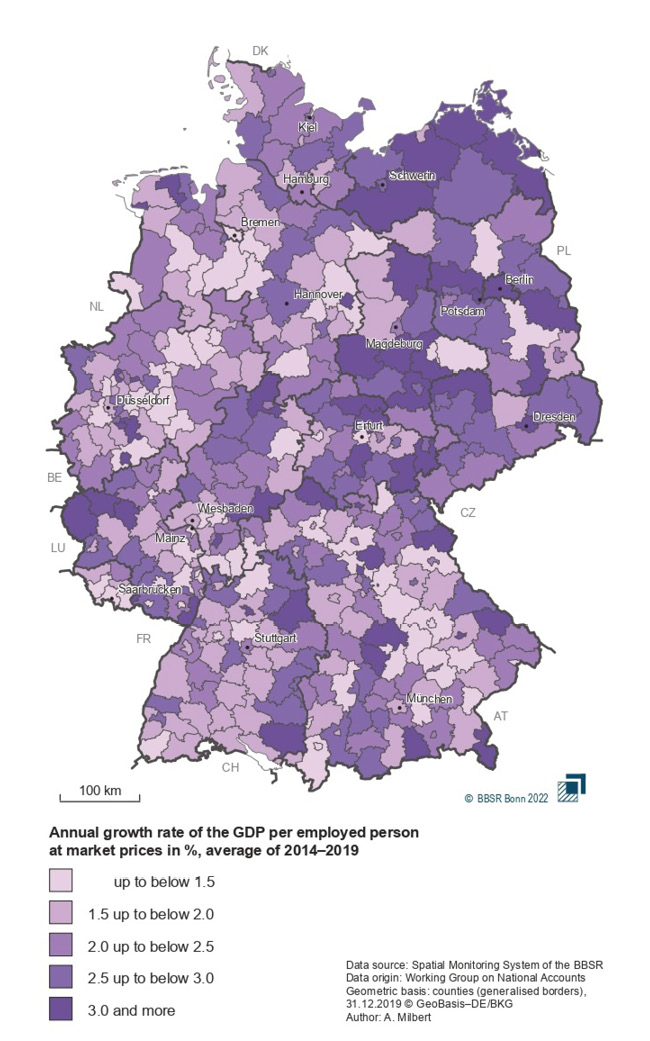
Fig. 2a. Annual growth rate of the Gross Domestic Product per employed person in Germany
Source: Binot et al., 2022c.
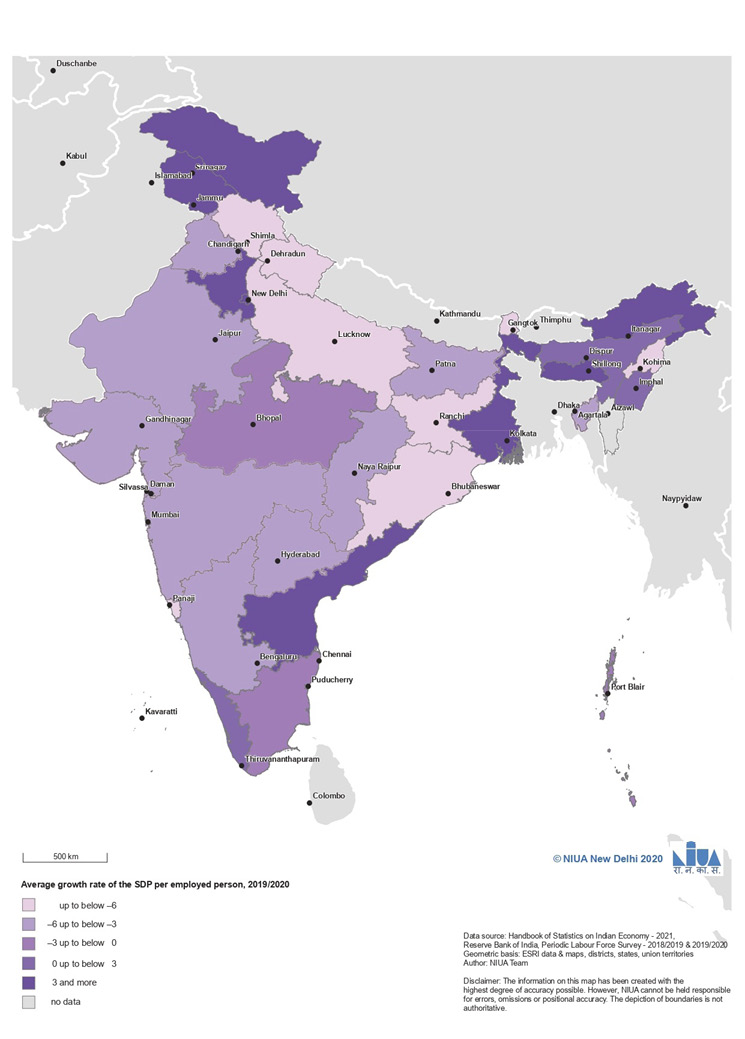
Fig. 2b. Annual growth rate of the State Domestic Product per employed person in India
Source: Binot et al., 2022c.
The available data on the micro level seldom fulfils the requirements of highly disaggregated level information with regard to age, gender, skill or social status. A policy demanding to ‘leave no one behind’ would need such fine granular data information. However, core statistics on the local and regional levels, as well as personal data protection mechanisms prohibit the use of numerical values beyond the aggregated total sum of inhabitants or employees. Therefore, the people-centred goal of leaving no one behind cannot be measured on the local level of communities and cities. The spatial picture of disaggregated level information thus delivers only a rough idea on SDG 8.5 of where all women, men, young people, and persons with disabilities might find decent working places (Binot et al., 2022b).
Another important aspect to consider is that socio-economic factors influence the health status of a person, as well as the health care situation of an authority, institution or territory – independently from the development status of the related country. Maps on Germany and India both reveal this correlation (see Fig. 3a and 3b): the higher the economic level and the average income of a region is, the higher the life expectancy there is. Better skilled workers generally move to regions with higher economic outputs and are able to pay for better healthcare there.
Sometimes, data is collected via web search or it is estimated, as no reliable surveys of official statistics exist in a local and regional context. This approach is remarkable, particularly in countries where a respective national legislation exists. An example herewith are women’s quota in bodies of political representation (see Fig. 4a and 4b). Quota exist in India with regard to their Panchayati Raj Institutions. In Germany, too, a respective (voluntary) quota for women exist, yet there is no obligation to publish the results of elections or the representation per gender of women and men in parliaments.
Pre-selecting respective indicators incorporates a certain responsibility of (and affordability for) cities and communities to (voluntarily) contribute, although the local level might not always be the appropriate level of observation. Especially in the field of services of general interest, local authorities also provide services to surrounding municipalities. An example might refer to the provision of medical (family) doctors. The higher the value of this service is, the more it is concentrated in larger cities as service locations for larger catchment areas, which cannot necessarily be defined by administrative boundaries. Appropriate spatial boundaries would thus have to be defined for monitoring purposes on a case by case basis. Very small-scale grid-based data is suitable herewith, because it may be applied very flexibly in order to generate varying spatial references. It goes without saying that data of this fine granular grid cells is not available for most topics. The most advanced progress has been made on the monitoring of land use and urbanisation by applying the Global Human Settlement Layer (GHSL) (Evers et al., 2020; Milbert et al., 2021).
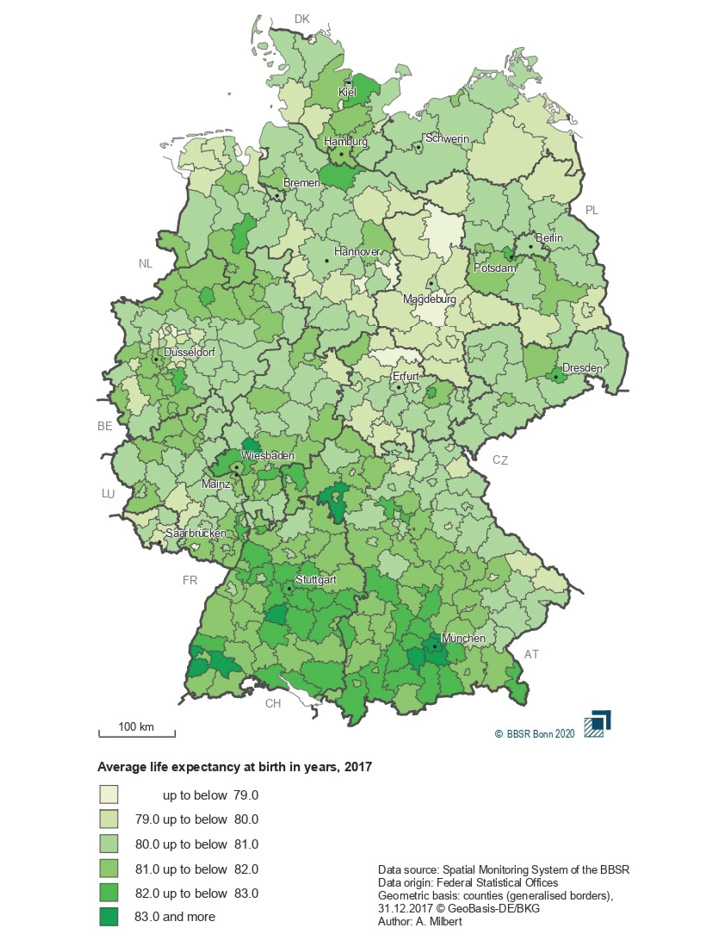
Fig. 3a. Life expectancy at birth in Germany
Source: Binot et al., 2020b.
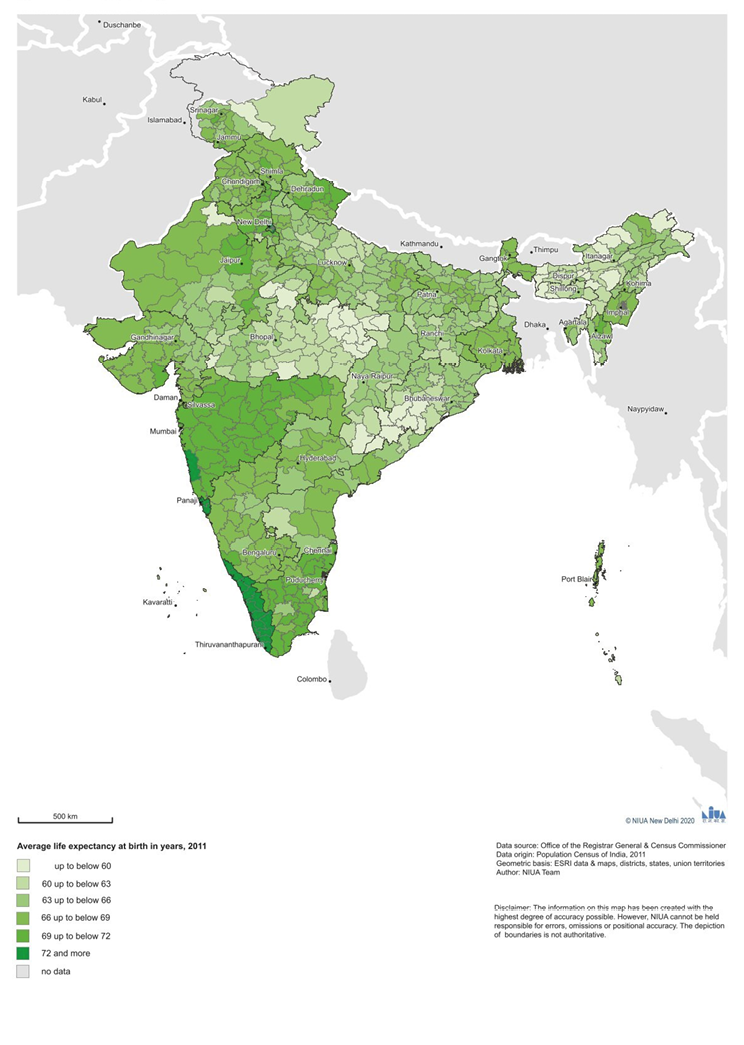
Fig. 3b. Life expectancy at birth in India
Source: Binot et al., 2020b.
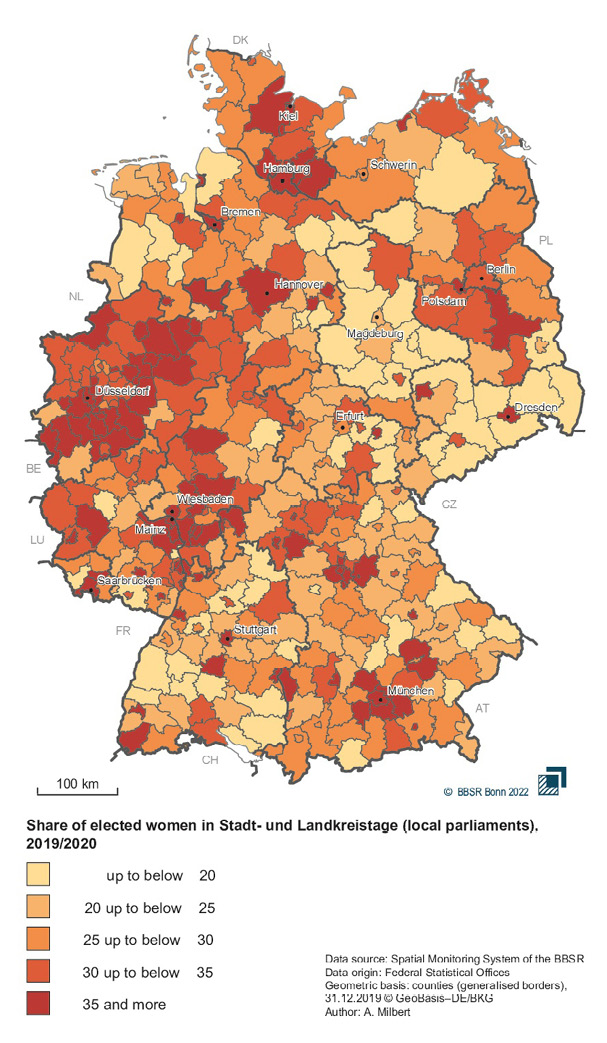
Fig. 4a. Elected women in Kreistage in Germany
Source: Binot et al., 2022b.
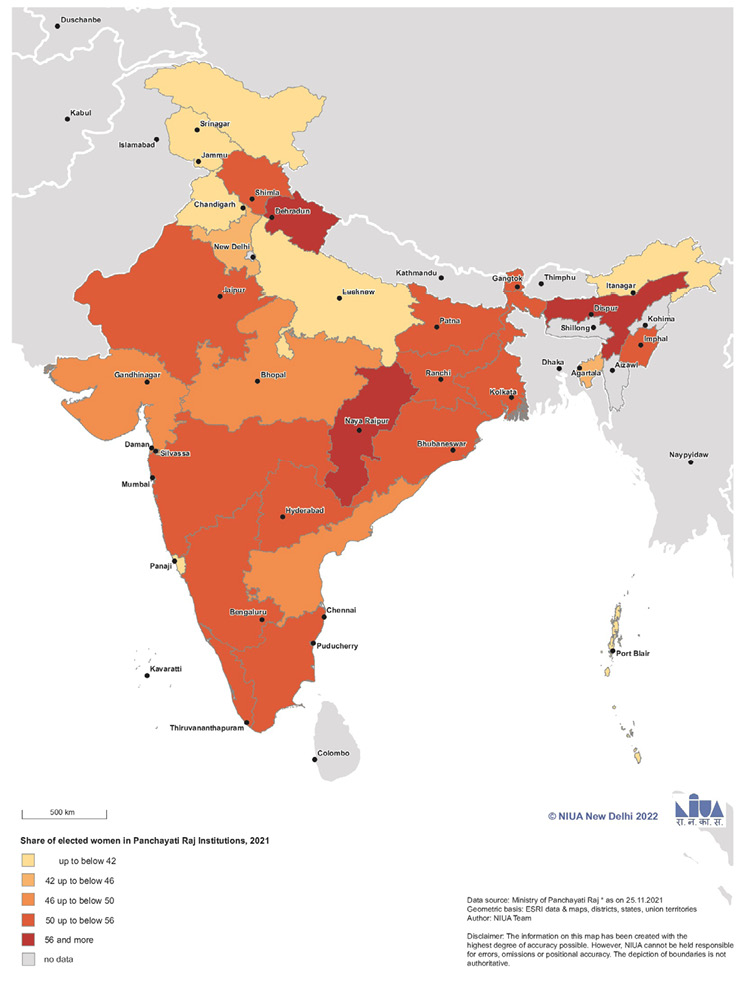
Fig. 4b. Elected women in Panchayati Raj Institutions in India
Source: Binot et al., 2022b.
The example of institutions of higher education also reveals the spatial differences between larger cities. As some universities are specialised to a certain degree in their field of expertise, they attract either more male or female students (see Fig. 5a and 5b). The respective indicators on gender equality refer to these specialisations, yet analysing specific spatial pictures requires a lot of local knowledge about these specialisations in order to correctly interpret the situation and thus derive target-oriented policy recommendations.
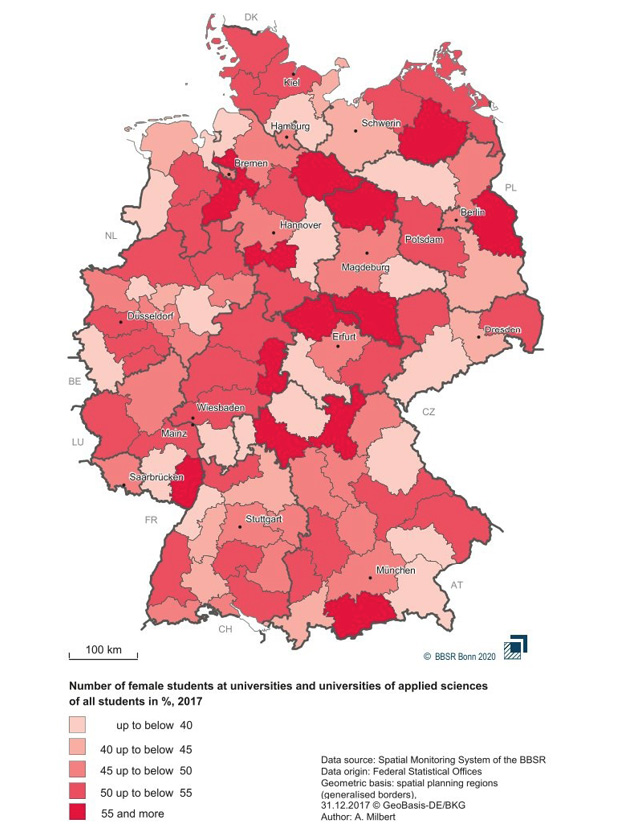
Fig. 5a. Female students in Germany
Source: Binot et al., 2020c.

Fig. 5b. Female students in India
Source: Binot et al., 2020c.
SDG 8.1 proposes an annual GDP growth rate as an indicator for measuring the development of an economy. This rate should be at least 7% in developing countries. Unfortunately, the COVID-19 pandemic had a global impact on various economies – in many countries with regional and local differentiations. Due to this kind of external shocks, an annual growth rate seems less favourable and suitable. On the contrary, a multi-annual average of such development rates should be recommended. As shown by Fig. 2a and 2b, the increase of the GVA in Germany refers to a five-year observation period and in India to the development in 2020 compared to the one in 2019. A weakened economy, in that respect due to the COVID-19 pandemic and its related contact restrictions, become falsely evident.
Very vague ideas are also provided by other sub-goals of the SDGs. The local and regional comparison in an international perspective thus requires more clarity – at best the concrete indication of multi-year time intervals.
Before drawing a joint conclusion, it seems appropriate to look at each geography and cultural context, as well as their specificities in science and policy.
A future targeted design of a consolidated and verticalised reporting on the progress (or regress) of implementing the SDGs and the New Urban Agenda was already drafted by Milbert, Mueller, Schmidt-Seiwert and Schoen in 2017. Reviewing this design and its elements reveals that the various existing expert networks still need to be interlinked in more depth in Germany. They consist of Statistical Offices of the Federal Government and the Länder, diverse regional expert groups and individuals of sectoral policies and bodies, nationwide networks of local authorities, as well as the national experience in urban development policies and, last but not least, BBSR as a possible anchor point in this web of knowledge. In that respect, the vertical dialogue of the National Urban Development Policy as a joint initiative of the Federal Government, the Länder and all cities and communities in Germany could be enlarged by a joint monitoring system of the development of cities and communities. The National Urban Development Report, which has to be published at least once per legislative period, could be linked, for example, with the Voluntary Local Reviews of the local level (cf. above), as well as possible subsequent national progress reports on the implementation of the New Urban Agenda. Their indicator orientation could be based on the respective data technique applied by the Federal Sustainability Strategy.
A large amount of knowledge has been gathered so far. Considering data and indicators, the Working Group on SDG Indicators for Communities (Bertelsmann Stiftung et al., 2020) is to be named in the same way as the aforementioned first National Report on the implementation of the New Urban Agenda (BBSR, 2021) and the analytical work in Germany (but also Europe) and India (Binot et al., 2020a–d, 2022, 2023), conducted by the research cooperation of BBSR and NIUA. This knowledge is being applied in concrete terms and actions as described above with regard to Voluntary Local Reviews (BBSR, 2022).
The analytical and indicator-related work seems to be fruitful and rewarding. It also seems as if in Germany the Committee of State Secretaries on Sustainable Development (in German: Staatssekretärsaussschuss für nachhaltige Entwicklung) as central body of the Federal Sustainability Strategy acknowledged in mid 2023 this work across levels by adopting concrete measures to be taken in the future in order to emphasise that local and regional levels are of crucial importance for implementing the SDGs. A vertical as well as multi-level data approach might thus serve as an appropriate way forward. Nevertheless, it has to be stressed repeatedly: such an approach is only sustainable and of relevance for the daily practices in local and regional authorities if communities of all sizes and geographical positions take part in and co-carry on this joint work.
India has adopted an SDG Framework and aligned its development programmes with the global targets of the SDGs. Several initiatives have been taken so far by the Government of India to implement the SDG Framework and monitor the progress (or regress) at the national, state, district and local levels. SDG India Index Reports are published at the national as well as the state levels, based on an interactive online dashboard developed by NITI Aayog. All states of India have to develop their own monitoring dashboards with which their respective progress (or regress) may be monitored and visualised. All dashboards at the state level will be integrated in the one of NITI Aayog. However, a couple of challenges exist in monitoring the implementation of the SDGs in India: granular data is still absent on the city or ward level for most critical indicators. Furthermore, official agencies do not supply data beyond the ward level. Unlike some developed countries, the statistical system of India has yet to collect and monitor data on the neighbourhood level. In that respect, it needs to be strengthened. A robust statistical system is thus required.
India has adopted so far a top-down approach in designing and monitoring the implementation of the SDGs by involving national and state governments. This effort has not yet percolated through to the city level, particularly small and medium-sized cities and communities as they often lack the administrative, financial, and technical resources to undertake this task (Khan, 2014). A SDG Cell is thus required in every local authority to collect and compile SDG-related data and link the data sets to the SDG Portal created by NITI Aayog. Cities and communities need a specific budget and human resources in order to perform accordingly and meet the targets set by the SDGs. A meaningful GIS-approach seems favourable. Capacity building and advocacy in localising the SDGs thus constitute most urgent needs in India.
A general data-related issue prevails though: municipal data, being the most important data source for assessing, for instance, the economic performance of cities and communities, have been disconnected in India from its Census since 2001. Additionally, the release of crucial data has been delayed for years – tables on inner migration, for example, gathered by the Census of 2011 were published in 2018.
Two aspects crystallise in a joint inferential view on verticalising the multi-level analysis of urban and spatial development across geographies: it is first about data and second about a constant conversation culture.
Statistical data is usually hardly available on the ground – at least not in the granular structure most wanted. That is the reason why often Big Data, crowd data-mining, remote sensing, and other forms of decentralised data-gathering are applied in order to fil the gap. Generating this kind of information is resource-consuming, though, and requires strategic decision-taking in order to make the best use of the resources available.
A conversation culture, which is worth its name, in order to arrive at the point in multi-level analysis of urban and spatial development and conduct straightforward talks about elements missing or to be adjusted, is a mammoth task. It would only be successful if there were constant feedback and resonance loops with all institutions, stakeholders, as well as groups and individuals involved.
The primary added value of research cooperations in that respect would be to test respective approaches across geographies and cultures and become aware of the pitfalls usually buried under daily life conditions. Last but not least, taking the expert perspective from two larger geographical contexts might boost the visibility and assertiveness of a joint endeavour and respective expert recommendations for practice in research and policy.
ALAIMO, L. S. and MAGGINO, F. (2020), ‘Sustainable Development Goals Indicators at Territorial Level: Conceptual and Methodological Issues – The Italian Perspective’, Social Indicators Research, 147, pp. 383–419. https://doi.org/10.1007/s11205-019-02162-4
BBSR – FEDERAL INSTITUTE FOR RESEARCH ON BUILDING, URBAN AFFAIRS AND SPATIAL DEVELOPMENT (ed.) (2021), National Progress Report on the implementation of the New Urban Agenda, BBSR-Online-Publikation 03/2021, https://www.bbsr.bund.de/BBSR/EN/publications/OnlinePublications/2021/bbsr-online-03-2021-dl.pdf?__blob=publicationFile&v=4 [accessed on: 17.03.2023].
BBSR – FEDERAL INSTITUTE FOR RESEARCH ON BUILDING, URBAN AFFAIRS AND SPATIAL DEVELOPMENT (ed.) (2022a), Atlas der Stadt- und Regionalentwicklung. Unter besonderer Berücksichtigung der räumlichen Auswirkungen von COVID-19, Einzelpublikation, https://www.bbsr.bund.de/BBSR/DE/veroeffentlichungen/sonderveroeffentlichungen/2022/atlas-der-stadt-und-regionalentwicklung-dl.pdf;jsessionid=495940917F46D7A4C942B350BF2A060D.live11292?__blob=publicationFile&v=6 [accessed on: 17.03.2023].
BBSR – FEDERAL INSTITUTE FOR RESEARCH ON BUILDING, URBAN AFFAIRS AND SPATIAL DEVELOPMENT (ed.) (2022b), Implementing the 2030 Agenda locally through urban development. Cities, towns, villages and counties in a data- and guiding principle-based dialogue on urban development-related aspects of global sustainability, Research Project, https://www.bbsr.bund.de/BBSR/EN/research/programs/ExWoSt/year/2022/agenda-2030/01-start.html [accessed on: 17.03.2023].
BERTELSMANN STIFTUNG; BUNDESINTITUT FÜR BAU-, STADT- UND RAUMFORSCHUNG; DEUTSCHER LANDKREISTAG; DEUTSCHER STÄDTETAG; DEUTSCHER STÄDTE- UND GEMEINDEBUND; DEUTSCHES INSTITUT FÜR URBANISTIK; ENGAGEMENT GLOBAL; RAT DER GEMEINDEN UND EUROPAS / DEUTSCHE SEKTION (2020), SDG-Indikatoren für Kommunen – Indikatoren zur Abbildung der Sustainable Development Goals der Vereinten Nationen in deutschen Kommunen, Gütersloh.
BIERMANN, F., HICKMANN, T., SÉNIT, C.-A., BEISHEIM, M., BERNSTEIN, S., CHASEK, P., GROB, L., KIM, R. E., KOTZÉ, L. J., NILSSON, M., ORDÉÑEZ LLANOS, A., OKEREKE, C., PRADHAN, P., RAVEN, R., SUN, Y., VIJGE, M. J., VAN VUUREN, D. and WICKE, B. (2022), Scientific evidence on the political impact of the Sustainable Development Goals’, Nature Sustainability, 5, pp. 795–800. https://doi.org/10.1038/s41893-022-00909-5
BINOT, R., KIEL, L., KUNDU, D., MUELLER, A., PANDEY, A. and SCHMIDT-SEIWERT, V. (2020a), ‘Spatial Structures and Trends in Europe and Asia: A Joint Methodological Approach Based on the Global Human Settlement Layer’, Journal on Environment and Urbanization ASIA, 11 (2), September 2020, Thousand Oaks, pp. 195–217. https://doi.org/10.1177/0975425320958850
BINOT, R., DEBNATH, T., KAR, B., KUNDU, D., MILBERT, A., MISHRA, R., MUELLER, A. and SCHMIDT-SEIWERT, V. (2020b), India, Germany and Europe. A Spatial Perspective at SDG 3 on Good Health and Well-Being, BBSR-Analysen KOMPAKT 11/2020, Berlin / Bonn, urn:nbn:de:101:1-2020121613262266231525.
BINOT, R., DEBNATH, T., KAR, B., KUNDU, D., MILBERT, A., MISHRA, R., MUELLER, A. and SCHMIDT-SEIWERT, V. (2020c), India, Germany and Europe. A Spatial Perspective at SDG 4 on Quality Education, BBSR-Analysen KOMPAKT 13/2020, Berlin / Bonn, urn:nbn:de:101:1-2020121613315097044814.
BINOT, R., DEBNATH, T., KAR, B., KUNDU, D., MILBERT, A., MISHRA, R., MUELLER, A. and SCHMIDT-SEIWERT, V. (2020d), India, Germany and Europe. A Spatial Perspective at SDG 11 on Sustainable Cities and Communities, BBSR-Analysen KOMPAKT 15/2020, Berlin / Bonn, urn:nbn:de:101:1-2020121613372278727298.
BINOT, R., CHAKRAVORTY, S., KAR, B.; KUNDU, D., MILBERT, A., MUELLER, A. and SCHMIDT-SEIWERT, V. (2022a), India, Germany and Europe. A Spatial Perspective at SDG 5 on Gender Equality, BBSR-Analysen KOMPAKT 03/2022, Berlin / Bonn, urn:nbn:de:101:1-2022070611484689452937.
BINOT, R., DAS, K. S., DEBNATH, T., KUNDU, D., MILBERT, A., MUELLER, A. and SCHMIDT-SEIWERT, V. (2022b), India, Germany and Europe. A Spatial Perspective at SDG 8 on Decent Work and Economic Growth, BBSR-Analysen KOMPAKT 05/2021, Berlin / Bonn, urn:nbn:de:101:1-2022070611314687560973.
BINOT, R., CHAKRAVORTY, S., DEBNATH, T., KIEL, L., KUMAR DAS, G., KUNDU, D., MILBERT, A., MUELLER, A. and SCHMIDT-SEIWERT, V. (2023), India, Germany and Europe. A Spatial Perspective at SDG 7 on Clean and Affordable Energy, BBSR-Analysen KOMPAKT 01/2023, Berlin / Bonn.
DE LEEUW, J., MEIJER, E. and GOLDSTEIN, H. (2008), Handbook of multilevel analysis, New York: Springer. https://doi.org/10.1007/978-0-387-73186-5
DESTATIS – STATISTISCHES BUNDESAMT (ed.) (2021), Nachhaltige Entwicklung in Deutschland, Wiesbaden: Indikatorenbericht.
EVERS, D., VAN SCHIE, M., VAN DEN BROEK, L., VAN ECK, J. R., VAN RIJN, F., VAN DER WOUDEN, R., SCHMIDT-SEIWERT, V., HELLINGS, A., BINOT, R., KIEL, L., COTELLA, G., RIVOLIN, U. J., SOLLY, A., BERISHA, E., CASAVOLA, D., DI TORINO, P., KATURIC, I., GREGAR, M., SIMOV, S., PAVLEK, K., LIPOVAC, R., FARINÓS-DASÍ, J., LLAUSÀS, A., ZORNOZ-GALLEGO, C., CELINSKA-JANOWICZ, D., PLOSZAJ, A., WOJNAR, K., GAUPP-BERGHAUSEN, M., DALLHAMMER, E., SCHUH, B. and CLAUS, T. (2020), SUPER – Sustainable Urbanization and land-use Practices in European Regions. ESPON applied research, Main Report, https://www.espon.eu/sites/default/files/attachments/ESPON%20SUPER%20Final%20Report%20-%20Main%20report_newtemplate.pdf [accessed on:17.03.2023].
HOX, J. J. and KREFT, I. G. (1994), ‘Multilevel analysis methods’, Sociological Methods & Research, 22 (3), pp. 283−299.
HOX, J. J., MOERBEEK, M. and VAN DE SCHOOT, R. (2017), Multilevel analysis: Techniques and applications, New York: Routledge. https://doi.org/10.4324/9781315650982
KHAN, S. (2014), The other JNNURM: what does it mean for small towns in India? CPR Urban Working Paper 4, New Delhi: Centre for Policy Research.
KUMAR, P., AHMED, F., SINGH, R. K. and SINHA, P. (2018), ‘Determination of hierarchical relationships among sustainable development goals using interpretive structural modelling’, Environment, Development and Sustainability, 20, pp. 2119−2137. https://doi.org/10.1007/s10668-017-9981-1
LANDESREGIERUNG NORDRHEIN-WESTFALEN (ed.) (2021), Die Globalen Nachhaltigkeitsziele konsequent umsetzen, Nachhaltigkeitsindikatoren Nordrhein-Westfalen Bericht 2020, Düsseldorf.
LANGE, P., PAGEL, J., SCHICK, C., EICHHORN, S. and REITZER, K. (2020), Der Beitrag kommunaler Nachhaltigkeitsstrategien zur Umsetzung der Agenda 2030 - die handlungsleitende Ebene (operative Ziele und Maßnahmen) auf dem Prüfstand. Die Nachhaltigkeitsagenda der Vereinten Nationen: Konzept, Entstehung und Wirkung der Sustainable Development Goals, Tagung des DVPW Arbeitskreises Umweltpolitik / Global Change, 5.-6. März 2020 im Schader-Forum, Darmstadt, https://www.lag21.de/files/default/pdf/Themen/Forschung/der-beitrag-kommunaler-nachhaltigkeitsstrategien-zur-umsetzung-der-agenda-2030-die-handlungsleitendeebene-operative-ziele-und-manahmen-auf-dem-prfstand-2020.pdf [accessed on: 17.03.2023].
LOHSE, E. (2017), ‘Eine Positionsbestimmung deutscher Kommunen zur New Urban Agenda’, Informationen zur Raumentwicklung, 3, pp. 32−41.
LFU – BAYERISCHES AMT FÜR UMWELT (ed.) (2022), Vorläufige Jahreskurzauswertung 2022 für Stickstoffdioxid und Feinstaub, https://www.lfu.bayern.de/luft/immissionsmessungen/lufthygienische_berichte/doc/jahreskurzberichte/jk22_vorlaeufig.pdf [accessed on: 17.03.2023].
MILBERT, A., MUELLER, A., SCHMIDT-SEIWERT, V. and SCHOEN, K. P. (2017), ‘Die New Urban Agenda. Kernstück eines globalen Monitoring-Systems’, [in:] BBSR – BUNDESINSTITUT FÜR BAU-, STADT- UND RAUMFORSCHUNG (Hrsg.) (2017), Die New Urban Agenda. Konsequenzen für die Stadtentwicklung. Informatione zur Raumentwicklung (IzR), Heft 3/2017, pp. 14–23, Bonn.
MILBERT, A., MUELLER, A. and SCHMIDT-SEIWERT, V. (2021), ‘Ebenenübergreifendes Monitoring. Lokal, regional, national, europäisch und global’, [in:] BBSR – BUNDESINSTITUT FÜR BAU-, STADT- UND RAUMFORSCHUNG (HRSG.) (2021), Stadtentwicklung beobachten, messen und umsetzen. Informationen zur Raumentwicklung (IzR), Heft 1/2021, pp. 20–31, Bonn.
MWANIKI, D. and NDUGWA, R. (2021), ‘The Global Urban Monitoring Approach Taken by UN-HABITAT’, [in:] BBSR – BUNDESINSTITUT FÜR BAU-, STADT- UND RAUMFORSCHUNG (HRSG.) (2021), Stadtentwicklung beobachten, messen und umsetzen. Informationen zur Raumentwicklung (IzR), Heft 1/2021, pp. 32–43, Bonn.
SNIJDERS, T. A. and BOSKER, R. J. (2011), Multilevel analysis: An introduction to basic and advanced multilevel modelling, SAGE. https://doi.org/10.1007/978-3-642-04898-2_387
STERLING, E. J., PASCUA, P., SIGOUIN, A., GAZIT, N., MANDLE, L., BETLEY, E., AINI, J., ALBERT, S., CAILLONC, S., CASELLE, J. E., CHENG, S. H., CLAUDET, J., DACKS, R., DARLING, E. S., FILARDI, C., JUPITER, S. D., MAWYER, A., MEJIA, M., MORISHIGE, K., NAINOCA, W., PARKS, J., TANGUAY, J., TICKTIN, T., VAVE, R., WASE, V., WONGBUSARAKUM, S. and MCCARTER, J. (2020), ‘Creating a space for place and multidimensional well-being: lessons learned from localizing the SDGs’, Sustainability Science, 15 (4), pp. 1129–1147. https://doi.org/10.1007/s11625-020-00822-w
UNITED NATIONS, GENERAL ASSEMBLY (2015), Transforming our World: The 2030 Agenda for Sustainable Development. A/RES/70/1.
UNITED NATIONS, GENERAL ASSEMBLY (2017), New Urban Agenda. A/RES/71/256.

